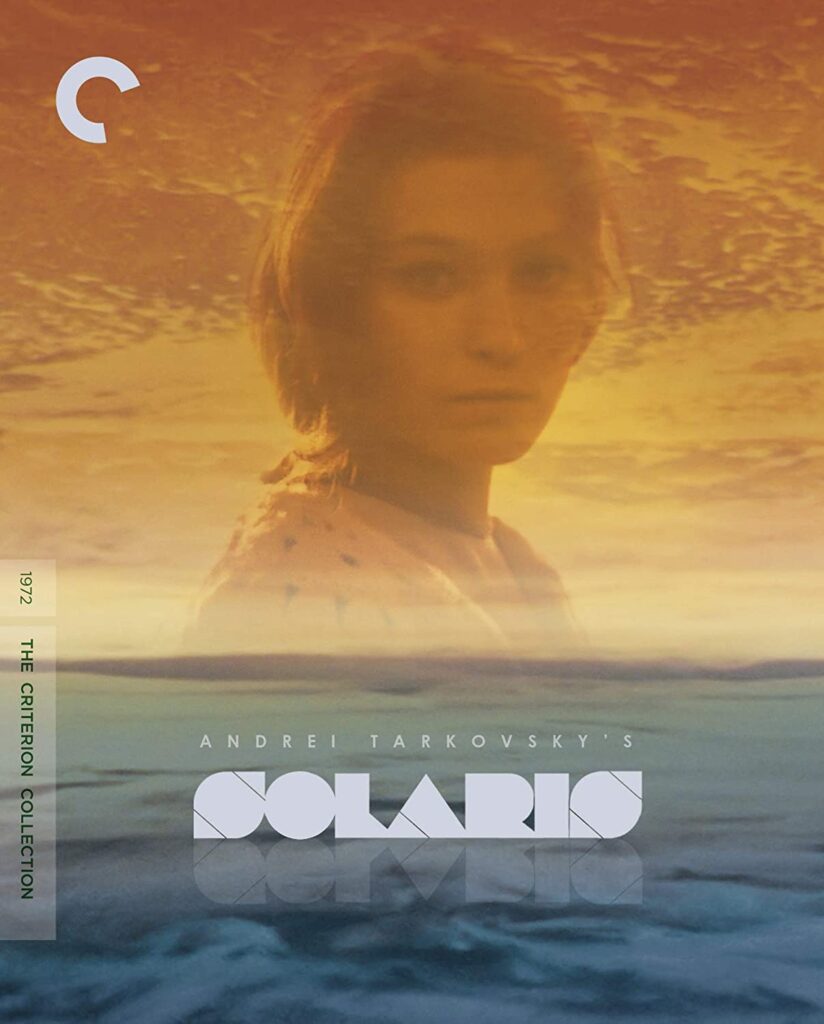
Director Andrei Tarkovsky used Stanislaw Lem’s 1961 science fiction novel Solaris as the basis for his story about a man coping with his disconnection from life. Though the majority of the film takes place aboard a space station in orbit around the ocean planet Solaris, it could be set anywhere as the main character focuses on an inner conflict. Unfortunately, the film becomes as self absorbed as the station crew members who are suffering psychological breakdowns. The meandering pace, augmented by the use of long takes, left me wanting to be the subject of a rescue mission before the 166-minute runtime was over.
Soviet psychologist Kris Kelvin (Donatas Banionis) accepts an assignment to the Solaris space station to discover what has happened to its crew of scientists because little work has occurred during the years they’ve spent there. Kris meets Henri Burton (Vladislav Dvorzhetsky), whose report of what took place on the station was dismissed as hallucinations by his superiors. Before leaving, Kris says goodbye to his father, who he will likely not see again because of the great distance of his interstellar flight, and burns many of his belongings.
Once aboard the space station, Kris finds the place out of control. Equipment is cluttered about; his friend Dr. Gibarian (Sos Sargsyan) is dead; and the two remaining crew members, Dr. Snaut (Jüri Järvet) and Dr. Sartorius (Anatoly Solonitsyn), offer conflicting information about what is happening. Complicating matters is the appearance of a beautiful young woman. She looks like Kris’ wife Hari (Natalya Bondarchuk), who committed suicide years ago. He tries to get rid of her but she keeps re-appearing. Rather than deal with how this is possible, her presence overwhelms Kris with thoughts and emotions associated with Hari, distracting him from his mission and potentially leaving him in the same state as the other crew members.
Criterion presents Solaris with a 1080p/MPEG-4 AVC encoded transfer displayed at 2.35:1 made “from a 35mm low-contrast print made from the original negative.” It was cleaned up with MTI’s DRS system, Pixel Farm’s PFClean system, and Digital Vision’s DVNR system, yet the film still shows its age with slight defects apparent and a flicker in an early exterior scene when Henri visits Kris. The colors lean toward dull but the hues are solid. Blacks are inconsistent, slightly faded in some scenes, strong in others. The details are sharp with textures of clothing and equipment well defined. In fact, they are so good the believability of the make up in some scenes is diminished. The audio is a Russian mono track “remastered at 24-bit from a 35mm optical soundtrack positive” and is limited by the source, which has the greatest impact on Eduard Artemyev’s score.
Recorded for Criterion in 2002, Vida Johnson and Graham Petrie, co-authors of The Films of Andrei Tarkovsky: A Visual Fugue, use the material collected in their book to speak to Solaris’ visual style, aesthetics, and themes in the commentary track. They also discuss the film’s production history, Tarkovsky’s working methods, his problems with Soviet bureaucracy, as well as cultural and biographical info. The track is a bit dry, unintentionally mimicking the tone of the movie. The main reason is that they don’t have a conversation with each other, choosing instead to just spout information.
All the remaining features are presented in 1080i. Deleted and Alternate Scenes (25 min) – Nine scenes were cut from the original version of the film before it went to the Cannes Film Festival. Thought to be lost, they were found in a Russian film archive and are included here. Author Stanislaw Lem (5 min) appears in a brief excerpt from a Polish television documentary where critics talk about the work. There are a number of interviews with those who worked on the film. Actress Natalya Bondarchuk (32 min) talks about getting the role of Hari and working with Tarkovsky. Cinematographer Vadim Yusov (34 min) collaborated with Tarkovsky on The Steamroller and the Violin (his graduation project), Ivan’s Childhood, Andrei Rublev, and Solaris. He discusses seeing Kubrick’s 2001, which impressed them, shooting Solaris, and what went onto creating the special effects. Art director Mikhail Romadin (17 min) goes into how he created the film’s look Composer Eduard Artemyev (22 min) reveals Bach’s influence on the score. The 20-page illustrated booklet has Phillip Lopate’s essay “Inner Space” and Akira Kurosawa’s “Tarkovsky and Solaris”.
While there are compelling elements and ideas in Solaris, Tarkovsky is his own worst enemy. As both co-writer and director, he needed to find the essentials of each scene and deliver those moments rather than let the scenes play out as long as he did. I enjoyed the conclusion but couldn’t understand why the journey was so long. The pacing may have a more natural, realistic flow, but this isn’t a documentary. I was not surprised to learn 30 minutes were cut from the film’s New York premiere in 1976 or that Stephen Soderbergh’s adaptation is only 99 minutes. It is unfortunate Tarkovsky couldn’t get out of his own way and producers weren’t able to guide him to a better result.